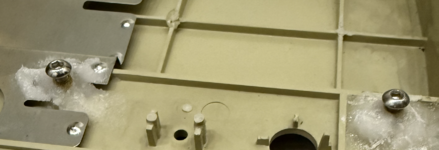I've spent most of the last two days using my PowerMac G5. On Tuesday, I used both my iMac G5 and PowerMac G5 in tandem, and by the end of the day it was unsurprisingly like a sauna in the room they both reside in. One of the USB Wi-Fi dongles I purchased arrived on Tuesday, so the first thing I did was plug it in to my PowerMac and install the necessary drivers. I booted into 10.5.6 since that's essentially become my testing grounds until the hard drive gets swapped out with that T-FORCE Z SSD you all saw in a previous post of mine. Below is a picture of the 802.11n USB Wi-Fi stick in the third USB port:

The product has the model number TEW-644UB by TrendNet and it uses RaLink drivers to connect to your home network wirelessly. The product also made its - I think - only mention on MacRumors in this post linked here: https://forums.macrumors.com/threads/802-11n-wifi-on-pci-e-g5.2289744/post-29727387. I searched for it online to try it out for myself and confirm for myself whether or not it works. I think I found only one seller who had it for sale online. The retail box claims only compatibility with Microsoft's Windows and requires a minimum of Windows 98 Second Edition, but it works with Mac OS X regardless. Inside the box comes with the product itself and a helpful USB male-to-female extension wire in case the dongle has too much girth that it prevents adjacent ports on your computer from being populated. It was unneeded in my case so I left it in the box. Here is the front and rear of the box:


The necessary drivers can be downloaded from the Macintosh Garden here at this link: https://macintoshgarden.org/apps/ralink-usb-wifi. Choose the first download that gives you the "RTUSB_D2870-3.0.3.0_UI-3.0.0.0_2010_09_10.dmg" file. The third download link is for Intel only. I was taken through the installer and the app "Wireless Utility" was created in the Applications folder upon the required system restart. The app works and it detected my network. With this dongle, I am able to connect to the internet wirelessly on the PowerMac G5. Great! If I want to grant 802.11n speeds to my other PowerPC Macs, then I'll know what dongle to use. The RaLink Wireless Utility app and its icon are somewhat incongruent with the rest of Mac OS X's user interface, but you can just quit the app after connecting to your network so you don't have to bother with it any more afterwards. I recommend doing this, anyway, since the app chugs about 30% of my DC 2.3 Ghz CPU and quitting the app doesn't disable your network connection.
After confirming that it works, I rebooted into 10.5.9 "Sorbet Leopard" on my SSD and installed the driver there as well. However, upon connecting to my home network, the system locks up and freezes with the dreaded spinning beach ball after no more than 60 seconds from connecting. The solution was simple. I had forgotten to disable IPv6 under "Advanced" in the Network tab of System Preferences. D'oh! Now everything works without a hitch!
With wireless networking behind me, I sought to work on my iMac G5 and PowerMac G5. My only one (I think?) USB flash drive formatted in FAT32 was running out of space and I didn't want to delete anything on it, so I turned on File Sharing within the iMac G5 and mounted its drive in my PowerMac G5's Finder by selecting Go ==> Connect to Server in Finder, or pressing Command+K on the keyboard. I logged in with the iMac's password and grabbed files from the iMac over the network to my PowerMac. My FireWire400 cable wasn't long enough to connect the two physically and I wanted to transfer the files wirelessly anyway, so I patiently waited for the file transfer to complete while I went and did other things on my PowerMac and iMac like browsing the web with AquaFox 2.1, listening to music in iTunes and Vox, configuring iStat Menus to my liking, and using VNC to remote control one of my other computers. I needed it to remember how I set up some of my forgotten software in the past.
Speaking of music, I have this random unbranded $5 USB-powered 5w mono speaker that I'm dedicating to my PowerMac. You don't get stereo and you don't get any bass. The shell is almost entirely hollow and it feels like it weighs 6 ounces, so most likely lighter than your smartphone. But, as an upgrade over the PowerMac's internal speaker, I'm pleased with it. I haven't been spoiled by $200+ surround sound Dolby Atmos speakers with powerful subwoofers and whatnot, so my little cheapo speaker suits my needs for this computer fine. It provides much more clarity and better highs than the internal speaker, but of course lows are practically nonexistent. The speaker sits underneath the desk. Pretty stellar for five bucks!

The product has the model number TEW-644UB by TrendNet and it uses RaLink drivers to connect to your home network wirelessly. The product also made its - I think - only mention on MacRumors in this post linked here: https://forums.macrumors.com/threads/802-11n-wifi-on-pci-e-g5.2289744/post-29727387. I searched for it online to try it out for myself and confirm for myself whether or not it works. I think I found only one seller who had it for sale online. The retail box claims only compatibility with Microsoft's Windows and requires a minimum of Windows 98 Second Edition, but it works with Mac OS X regardless. Inside the box comes with the product itself and a helpful USB male-to-female extension wire in case the dongle has too much girth that it prevents adjacent ports on your computer from being populated. It was unneeded in my case so I left it in the box. Here is the front and rear of the box:
The necessary drivers can be downloaded from the Macintosh Garden here at this link: https://macintoshgarden.org/apps/ralink-usb-wifi. Choose the first download that gives you the "RTUSB_D2870-3.0.3.0_UI-3.0.0.0_2010_09_10.dmg" file. The third download link is for Intel only. I was taken through the installer and the app "Wireless Utility" was created in the Applications folder upon the required system restart. The app works and it detected my network. With this dongle, I am able to connect to the internet wirelessly on the PowerMac G5. Great! If I want to grant 802.11n speeds to my other PowerPC Macs, then I'll know what dongle to use. The RaLink Wireless Utility app and its icon are somewhat incongruent with the rest of Mac OS X's user interface, but you can just quit the app after connecting to your network so you don't have to bother with it any more afterwards. I recommend doing this, anyway, since the app chugs about 30% of my DC 2.3 Ghz CPU and quitting the app doesn't disable your network connection.
After confirming that it works, I rebooted into 10.5.9 "Sorbet Leopard" on my SSD and installed the driver there as well. However, upon connecting to my home network, the system locks up and freezes with the dreaded spinning beach ball after no more than 60 seconds from connecting. The solution was simple. I had forgotten to disable IPv6 under "Advanced" in the Network tab of System Preferences. D'oh! Now everything works without a hitch!
With wireless networking behind me, I sought to work on my iMac G5 and PowerMac G5. My only one (I think?) USB flash drive formatted in FAT32 was running out of space and I didn't want to delete anything on it, so I turned on File Sharing within the iMac G5 and mounted its drive in my PowerMac G5's Finder by selecting Go ==> Connect to Server in Finder, or pressing Command+K on the keyboard. I logged in with the iMac's password and grabbed files from the iMac over the network to my PowerMac. My FireWire400 cable wasn't long enough to connect the two physically and I wanted to transfer the files wirelessly anyway, so I patiently waited for the file transfer to complete while I went and did other things on my PowerMac and iMac like browsing the web with AquaFox 2.1, listening to music in iTunes and Vox, configuring iStat Menus to my liking, and using VNC to remote control one of my other computers. I needed it to remember how I set up some of my forgotten software in the past.
Speaking of music, I have this random unbranded $5 USB-powered 5w mono speaker that I'm dedicating to my PowerMac. You don't get stereo and you don't get any bass. The shell is almost entirely hollow and it feels like it weighs 6 ounces, so most likely lighter than your smartphone. But, as an upgrade over the PowerMac's internal speaker, I'm pleased with it. I haven't been spoiled by $200+ surround sound Dolby Atmos speakers with powerful subwoofers and whatnot, so my little cheapo speaker suits my needs for this computer fine. It provides much more clarity and better highs than the internal speaker, but of course lows are practically nonexistent. The speaker sits underneath the desk. Pretty stellar for five bucks!




